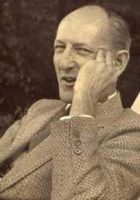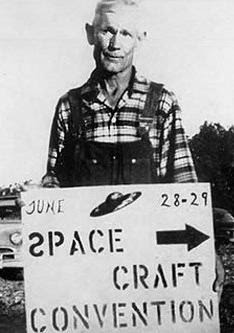by Charles Lear
 Of all the private organizations devoted to UFO investigation, the National Investigations Committee on Aerial Phenomena was arguably the most ambitious and tenacious. This was driven in large part by its director, Donald Keyhoe. Keyhoe held the beliefs that UFOs are extraterrestrial and that the U.S. Government, particularly the Air Force, was keeping information from the public that could possibly prove the ET hypothesis. As effective as NICAP was at hounding the Air Force and convincing many in the U.S. Congress that UFOs were deserving of scientific study, there are indications that the CIA was involved in both the beginning and the end of the organization.
Of all the private organizations devoted to UFO investigation, the National Investigations Committee on Aerial Phenomena was arguably the most ambitious and tenacious. This was driven in large part by its director, Donald Keyhoe. Keyhoe held the beliefs that UFOs are extraterrestrial and that the U.S. Government, particularly the Air Force, was keeping information from the public that could possibly prove the ET hypothesis. As effective as NICAP was at hounding the Air Force and convincing many in the U.S. Congress that UFOs were deserving of scientific study, there are indications that the CIA was involved in both the beginning and the end of the organization.
 Todd Zechel wrote about the CIA – NICAP connection in the January 1979 issue of Just Cause, the newsletter put out by Citizens Against UFO Secrecy. NICAP was incorporated in 1956, and two men Zechel argues were covert CIA operatives were put into chair positions within the organization. One of these men was Bernard J. O. Carvalho, who was made the chairman of NICAP’s membership subcommittee According to Zechel, Carvalho worked as a “front man” for companies secretly run by the CIA. The other was “Count” Nicolas de Rochefort, who was made Vice-Chairman of NICAP. According to Zechel, de Rochefort worked with the CIA’s Psychological Warfare Staff. Zechel tells the reader “there is more than ample evidence to conclusively establish both de Rochefort and Cavalho were at least during certain periods of their lives covert employees of the Central Intelligence Agency.”
Todd Zechel wrote about the CIA – NICAP connection in the January 1979 issue of Just Cause, the newsletter put out by Citizens Against UFO Secrecy. NICAP was incorporated in 1956, and two men Zechel argues were covert CIA operatives were put into chair positions within the organization. One of these men was Bernard J. O. Carvalho, who was made the chairman of NICAP’s membership subcommittee According to Zechel, Carvalho worked as a “front man” for companies secretly run by the CIA. The other was “Count” Nicolas de Rochefort, who was made Vice-Chairman of NICAP. According to Zechel, de Rochefort worked with the CIA’s Psychological Warfare Staff. Zechel tells the reader “there is more than ample evidence to conclusively establish both de Rochefort and Cavalho were at least during certain periods of their lives covert employees of the Central Intelligence Agency.”
 The year 1957 was a very interesting one in UFO history. In that year, UFO occupant reports were accepted as worthy of investigation by serious organizations such as the Aerial Phenomena Research Organization and Civilian Saucer Intelligence of New York; Contactees were in the spotlight thanks to the
The year 1957 was a very interesting one in UFO history. In that year, UFO occupant reports were accepted as worthy of investigation by serious organizations such as the Aerial Phenomena Research Organization and Civilian Saucer Intelligence of New York; Contactees were in the spotlight thanks to the